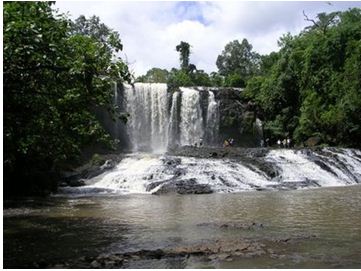Defining “Ecotourism” has proven to be a difficult task given all the different players attempting to define it. People tend to define things in terms that are beneficial to themselves, hence the variety of definitions. There are however several workable definitions currently in wide use.
The International Ecotourism Society defines Ecotourism as: “responsible travel to natural areas that conserves the environment and improves the welfare of local people”.
Characteristics of Ecotourism
1) Involves travel to natural destinations: These destinations are often remote areas, whether inhabited or uninhabited, and are usually under some kind of environmental protection at the national, international, communal or private level.
2) Minimizes Impact: Tourism causes damage. Ecotourism strives to minimize the adverse affects of hotels, trails, and other infrastructure by using either recycled materials or plentifully available local building materials, renewable sources of energy, recycling and safe disposal of waste and garbage, and environmentally and culturally sensitive architectural design. Minimization of impact also requires that the numbers and mode of behavior of tourists be regulated to ensure limited damage to the ecosystem.
3) Builds environmental awareness: Ecotourism means education, for both tourists and residents of nearby communities. Well before departure tour operators should supply travelers with reading material about the country, environment and local people, as well as a code of conduct for both the traveler and the industry itself. This information helps prepare the tourist as The Ecotourism Societies guidelines state “to learn about the places and peoples visited” and “to minimize their negative impacts while visiting sensitive environments and cultures”.
4) Provides direct financial benefits for conservation: Ecotourism helps raise funds for environmental protection, research and education through a variety of mechanisms, including park entrance fees, tour company, hotel, airline and airport taxes and voluntary contributions.
5) Provides financial benefits and empowerment for local people: National Parks and other conservation areas will only survive if there are “happy people” around their perimeters. The local community must be involved with and receive income and other tangible benefits (potable water, roads, health clinics, etc.) from the conservation area and it’s tourist facilities. Campsites, lodges, guide services, restaurants and other concessions should be run by or in partnership with communities surrounding a park or other tourist destination.
6) Respects local culture: Ecotourism is not only “greener” but also less culturally intrusive and exploitative than conventional tourism. Whereas prostitution, black markets and drugs often are by-products of mass tourism, ecotourism strives to be culturally respectful and have a minimal effect on both the natural environment and the human population of a host country. This is not easy, especially since ecotourism often involves travel to remote areas where small and isolate communities have had little experience interacting with foreigners.
7) Supports human rights and democratic movements: Although tourism often is glibly hailed as a tool for building international understanding and world peace, this does not happen automatically; frequently in fact tourism bolsters the economies of repressive and undemocratic states. Mass tourism pays scant attention to the political system of the host country or struggles within it, unless civil unrest spills over into attacks on tourists. Ecotourism demands a more holistic approach to travel, one in which participants strive to respect, learn about and benefit both the local environment and local communities.
Ideally, ecotourism should satisfy several criteria, such as:
- Conservation of biological diversity and cultural diversity through ecosystem protection
- Promotion of sustainable use of biodiversity, by providing jobs to local populations
- Sharing of socio-economic benefits with local communities and indigenous peoples by having their informed consent and participation in the management of ecotourism enterprises
- Tourism to unspoiled natural resources, with minimal impact on the environment being a primary concern.
- Minimization of tourism’s own environmental impact
- Affordability and lack of waste in the form of luxury
- Local culture, flora and fauna being the main attractions
For many countries, ecotourism is not simply a marginal activity to finance protection of the environment, but is a major industry of the national economy. For example, in Costa Rica, Ecuador, Nepal, Kenya, Madagascar and Antarctica, ecotourism represents a significant portion of the gross domestic product and economic activity.
The concept of ecotourism is widely misunderstood and in practice is often used as a marketing tool to promote tourism, which is related to nature. This is an especially frequent malpractice in the realm of Jungle tourism. Critics claim that these green-washing practices, carried out in the name of ecotourism, often consist of placing a hotel in a splendid landscape, to the detriment of the ecosystem. According to them, ecotourism must above all sensitize people to the beauty and the fragility of nature. They condemn some operators as green-washing their operations: using the labels of “green” and “eco-friendly”, while behaving in environmentally irresponsible ways.
Defining the Experience
There are almost as many terms to describe types of travel as there are travel companies. A couple of buzzwords that we often hear these days are “Eco-Tourism” and “Adventure Travel”. To further confuse the issue there is also “Sustainable Tourism”, “Responsible Tourism”, “Nature Based Travel”, “Green Travel”, “Multi-Sport Adventures” and “Cultural Tourism”. The following are Untamed Path’s definitions based on common usage.
Ecotourism: Perhaps the most over-used and misused word in the travel industry. But what does it mean? The Ecotourism Society defines it as “responsible travel to natural areas which conserves the environment and improves the welfare of the local people”. A walk through the rainforest is not eco-tourism unless that particular walk somehow benefits that environment and the people who live there. A rafting trip is only eco-tourism if it raises awareness and funds to help protect the watershed. A loose interpretation of this definition allows many companies to promote themselves as something that they are not. If true eco-tourism is important to you, ask plenty of questions to determine if your trip will help “conserve and improve” the places you visit.
Adventure Travel: Another term which is heavily used by marketing departments. While travel to another country is often adventurous it is not necessarily “Adventure Travel”. Most dictionaries define adventure similarly: “an unusual experience including some level of risk and uncertainty”. “Adventure Travel” includes this idea of risk and oftentimes some unconventional means of transport. A dugout canoe journey deep into the Amazon basin with its attendant difficulties meets this definition.
Sustainable Tourism: Any form of tourism that does not reduce the availability of resources and does not inhibit future travelers from enjoying the same experience. If the presence of large numbers of tourists disturbs an animal’s mating patterns so that there are fewer of that species in the future then that visit was not sustainable. Kayaking school on a free flowing river is an example of sustainable tourism. Big game hunting in Alaska is not.
Responsible Tourism: Tourism which operates in such a way as to minimize negative impacts on the environment. A wilderness camping trip using “Leave No Trace” ethics would be considered responsible tourism while dune buggy tours would not.
Nature-Based Tourism: A more generic term for any activity or travel experience with a focus on nature. Large jungle lodges fall into this category as do cruise ships to view penguins in Antarctica. These types of trips may or may not be environmentally sustainable or responsible. –
Green Tourism: Often used inter-changeably with eco-tourism and sustainable tourism but more accurately described as “any activity or facility operating in an environmentally friendly fashion”. A lodge with composting toilets, gray water system, and solar powered lighting is probably “green”. There are varying degrees of “greenness”; an awareness of where resources are coming from and where wastes are going is at the heart of the idea.
Multi-Sport Adventures: These trips have a focus on physical outdoor activities. Rafting, mountain biking, climbing, surfing, diving, etc. all offered in the same package. Not necessarily sustainable or eco but might be since many companies want to protect the areas where these activities take place.
Cultural Tourism: Interacting with and observing unique cultures is the focus of this style of trip. The concept of learning from other cultures to broaden ones perspective is usually a core value. An artisan showing you how to weave a tapestry and learning from them about their traditional dress would be a form of cultural tourism. Buying crafts in the market with no more interaction than the exchange of money does not provide the insight into another culture that is the central theme of cultural tourism.
Ecotourism Attractions of Bangladesh
Bangladesh is endowed with various tourist attractions which include archaeological sites, mosques, temples, monuments, modern resorts and a range of tours, including river cruises and boating. Visitors to Bangladesh are invariably brought close to nature. The following are the major tourist attractions.
Cox’s Bazar: This is the tourist capital of Bangladesh with a 120 km long sandy, straight and drivable beach. Thousands of tourists, foreign and local, visit this spot every year. The Inani beach, about 30 km from Cox’s Bazar, toward Teknaf, is a beautiful spot, full of coral stones. Not very far from Cox’s Bazar is the island of Maheskhali, famous for its Buddhist and Hindu temples and a dry fish industry. A trip to Tefnak, about 100 km from Cox’s Bazar, takes a visitor to the southern-most point of Bangladesh. It is simply fascinating. From there, one can go to the coral island of St. Martin by boat. Cox’s Bazar is connected to Chittagong and Dhaka by road and air.
Hilly Districts: The three Hilly Districts of Rangamata, Khagrachari and Bandarban are inhabited by a number of tribes, with their distinctive cultures, rituals and traditions. The picturesque town of Rangamati is about 70 km from the port city of Chittagong. The Kaptai Lake is the largest man-made lake in the sub-continent.
Chittagong: This port city is famous for its harbour and port, beach and hills, a World War II cemetery, the shrines of saints and beautiful mosques. It is the second largest city in the country and is the commercial capital. Sitakund, a holy place for Hindu pilgrims, is only 36 km from Chittagong. Chittagong is connected to Dhaka by road, train and air.
Dhaka: Situated on the bank of the Buriganga River, Dhaka is the national capital. Founded in 1608 AD as the seat of the imperial Mughal Viceroys of Bengal and known over centuries for its silk, muslin and pearls, Dhaka has many interesting attractions. These are the Lalbagh Fort (built in 1678 by Prince Azam, son of Mughal Emperor Aurangzeb), the Armenian Church, the Ahsan Manzil Museum (the residence of the Nawabs of Dhaka), the Star Mosque, the National Memorial at Savar, the Central Shadeed Minar (a monument dedicated to the sacred memory of the martyrs of the Language Movement, 1952), Curson Hall, the National Museum, the Baldah Gardens, the Botanical Garden and the National Park. Sonargaon, one of the oldest capitals of Bengal, is 25 km from the present capital of Dhaka.
Mahasthangar (Bogra): Dating back from the 3rd century BC, this is the earliest known city site in the whole of Bengal. One can see the ruins of an early Buddhist monastery near Mahasthangar.
Paharpur (Naogaon): This gigantic temple and monastery of the 8th century is by far the most spectacular Buddhist site that has been discovered. It has been declared a World Heritage site by UNESCO.
Dinajpur: Ramsagor Lake and the Kantajis Mandir (built in 1722) are two important attractions in this northern district. The Mandir, with mythological decorations in terracotta, depicts the entire story of Mahabharata.
Sixty Domes Mosque (Bagerhat): Built in 1454, with 77 domes, this is the most magnificent and certainly the largest brick mosque of Bangladesh. The mausoleum in memory of the Muslim mystic Khan Jahan Ali is located here. It has been declared as a World Heritage site by UNESCO.
The Sundarbans: A cluster of islands with an approximate area of 600 km² form the largest mangrove forest in the world. This is the abode of the Royal Bengal Tiger and a unique place for ecotourism. Only recently it has been declared a World Heritage site by UNESCO.
Comilla: Here the most important place to visit is Mainamati-Lalmai, an extensive centre of Buddhist culture (7th to 12th century), developed during the Chandra and the Deva dynasties.
Sylhet: This is the city of two great saints, Hazrat Shah Jalal (RA) and Hazrat Shah Paran (RA). It is a beautiful area with more than 130 tea gardens. Colourful Manipuri and Khasia tribes with their folk dances and distinct culture are added attractions.
Ecotourism Development in Bangladesh
Various tourism facilities have been developed in many of the potential tourism areas by the Bangladesh Parjatan (Tourism) Corporation and other government, semi-government and non-government agencies. The Government of Bangladesh formulated a National Tourism Policy in February 1992. The main objective of this policy is to attract investment in tourism from the domestic private sector as well as by foreign investors. The government encourages foreign investment in the sector, either in the form of joint ventures or on a full foreign ownership basis. In order to encourage investments, the government has put in place a number of incentives such as tax exemptions, remittances of up to 50% of the salary of foreign staff, facilities for repatriation of savings and retirement benefits, repatriation of capital and profits, and guarantees against nationalization.
There was a time not too far in the past when tourism focused on beach resorts with recreational facilities. However lately, ecotourism has developed as a major trend. Travelling to relatively undisturbed natural areas with the specific object of studying, admiring and enjoying the scenery and wild plants and animals is a new phenomenon in developing countries.
Complementary to ecotourism is the emerging concept of green productivity (GP). The term “green productivity” is based on a strategy for enhancing productivity and environmental performance with the goal being overall socio-economic development. GP is the application of appropriate techniques, technologies and management systems to provide environmentally compatible goods and services. The GP concept can be applied in manufacturing, the service sector, agriculture, and in personal consumption; but GP is particularly pertinent to the concept of ecotourism.












